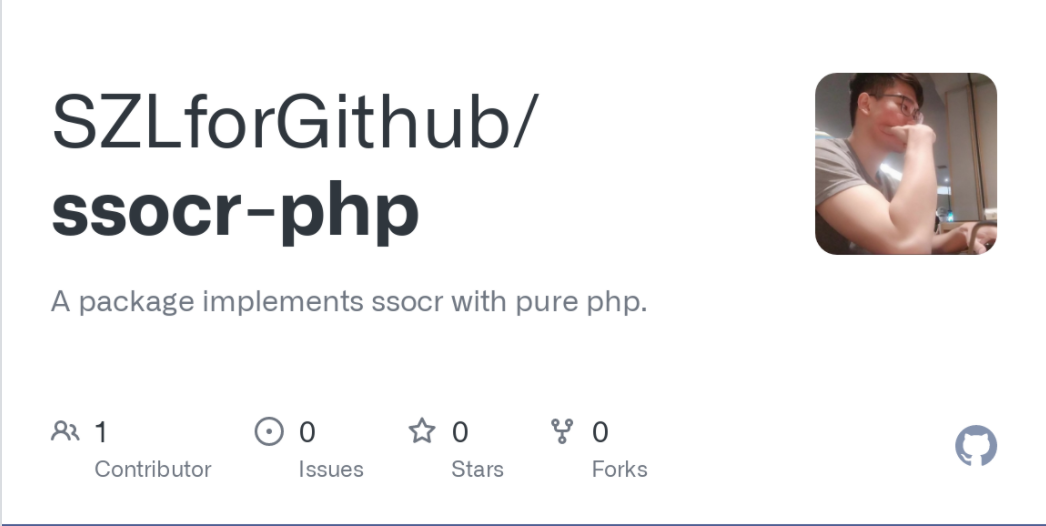SSOCR 在 PHP 中的實作
- 4 minutes read - 1972 words前言
Hi there,這次要分享的是最近工作上用到的 SSOCR (Seven Segment Optical Character Recognition) 功能,就是類似以下這樣的圖片:

這樣的顯示方式被稱為 Seven Segment,因為它是由七個柱狀體來組合成數字,常見的中文名稱是七字節或是七段顯示器。
而需要實作的功能,初步的想像是這樣的:前端會傳來一張這樣的圖片,然後由後端對這張圖片做簡單的處理和辨識,並回傳 73。
有哪些工具可以使用?
我第一步先嘗試了一些視覺辨識的套件,比如大名鼎鼎的 Google Cloud Vision API 和 Tesseract,但效果很出我意料的不甚理想,與其說是不甚理想,不如說根本完全無法辨識。
過程中做了一些 survey,主要的原因是一般的視覺辨識套件的流程是:
- 灰階
- 二值化
- 根據二值化後的黑點分佈來做字體的判斷
但是在七段顯示器中,每個柱狀體之間是有空間的,再加上每個柱狀體又奇形怪狀的,所以很容易被視為雜訊。
這一篇心得文主要會著重在演算法的實作,若是對嘗試過程和套件之間的比較有興趣的話,可以移駕我在公司內部分享會的簡報 (已移除產品相關的敏感資訊),裡面記錄了我撞牆的過程。
其實這種場景目前比較主流的解決方案都是 train 一個 AI model 去辨識,因為七段顯示器也算是相對單純的 input,但礙於時間壓力和我本人的經驗不足,所以並沒有在產品上選用這個方案。
解決方案
接著我進一步搜尋在特化情況下的視覺辨識套件,找到了這一個用 C 寫的 ssocr,稍微嘗試了一下確實可以正確辨識,在它的文件也把辨識的演算法寫得非常清楚,我心想真是太棒了,應該可以找到 PHP 版本吧,等下就解完可以去吃公司的零食了,結果…

哭啊,只找到一個 call C library 的 bridge,但又覺得這種解法很不乾淨,可能還要考慮 Command injection 和接踵而來的 Remote Code Execution (雖然最後還是採用這個方案),但我越想越不舒服,怎麼可以沒有呢?
登愣!我自己寫了一個,所以現在有了!
演算法實作
其實只是一個很簡單的小套件,我基本上就是參考了ssocr 文件中的做法:

以下僅擷取部分程式碼:
step 1. 灰階與二值化
首先一樣是做圖片處理,我也提供從外部傳入參數對圖片做 resize 的功能,因為有些過大的圖片會導致下一個步驟 timeout
...
$im->thresholdimage($this->threshold * Imagick::getQuantum());
list($width, $height) = $this->getWidthAndHeight($im);
if ($this->scale) {
$im->resizeImage(
$width / $this->scale,
$height / $this->scale,
Imagick::FILTER_LANCZOS,
1
);
}
list($width, $height) = $this->getWidthAndHeight($im);
...
step 2. 取得所有像素點與每個數字的邊界
第二步則是針對像素點的判斷和擷取,基本上 function 所做的事就如同它們的名字,要是有興趣請到 repository 內觀看。
...
$numberPixels = $this->getNumberPixels($im, $width, $height);
$numberPositions = $this->getXY($numberPixels);
...
getXY 會回傳一個像這樣的二維陣列,代表每一個數字的邊界的四個值:
array(2) {
[0] =>
array(4) {
'x1' =>
int(17)
'x2' =>
int(46)
'y1' =>
int(12)
'y2' =>
int(71)
}
[1] =>
array(4) {
'x1' =>
int(56)
'x2' =>
int(84)
'y1' =>
int(12)
'y2' =>
int(67)
}
}
step 3. 利用值來切割數字並辨識
...
$im->writeImage('tmp.' . $this->image);
$result = $this->getResult($numberPositions);
unlink('tmp.' . $this->image);
return $result;
核心 function 就是這個 getResult:
private function getResult($numberPositions)
{
$result = '';
foreach ($numberPositions as $key => $numberPosition) {
$im = new Imagick();
$im->readImage('tmp.' . $this->image);
$im->cropImage(
$numberPosition['x2'] - $numberPosition['x1'],
$numberPosition['y2'] - $numberPosition['y1'],
$numberPosition['x1'],
$numberPosition['y1']
);
$size = $im->getImageGeometry();
$width = $size['width'];
$height = $size['height'];
/**
* Since the algorithm cannot recognize the digit one,
* a digit that has a width of less than one quarter of it's height is recognized as a one.
*/
if ($width < $height / 4) {
$result .= '1';
break;
}
/**
* A vertical scan is started in the center top pixel of the digit to find the three horizontal segments.
* Any foreground pixel in the upper third is counted as part of the top segment,
* those in the second third as part of the middle and those in the last third as part of the bottom segment.
*/
$numberPixels = $this->getNumberPixels($im, $width, $height);
$line = [0, 0, 0, 0, 0, 0, 0];
$centerTop = floor($width / 2);
$thirdHeight = floor($height / 3);
$quarterLeft = floor($height / 4);
$halfWidth = floor($width / 2);
foreach ($numberPixels as $key => $numberPixel) {
if ($numberPixel['x'] == $centerTop) {
if ($numberPixel['y'] <= $thirdHeight) {
$line[0] = 1;
} elseif ($numberPixel['y'] <= $thirdHeight * 2) {
$line[1] = 1;
} elseif ($numberPixel['y'] <= $thirdHeight * 3) {
$line[2] = 1;
}
}
if ($numberPixel['y'] == $quarterLeft) {
if ($numberPixel['x'] <= $halfWidth) {
$line[3] = 1;
} elseif ($numberPixel['x'] >= $halfWidth) {
$line[4] = 1;
}
}
if ($numberPixel['y'] == $quarterLeft * 3) {
if ($numberPixel['x'] <= $halfWidth) {
$line[5] = 1;
} elseif ($numberPixel['x'] >= $halfWidth) {
$line[6] = 1;
}
}
}
foreach ($this->lineNumbers as $key => $lineNumber) {
if ($line == $lineNumber) {
$result .= $key;
break;
}
}
}
return $result;
}
上面這段註解的部分都是擷取自 SSOCR 的文件中一些比較特殊的判斷或是作法,基本上就是判斷每一個切出來的數字中,有黑色像素點的區域,並且把可能性條列出來,最後再比較:
/**
* --0--
* |3 |4
* | |
* --1--
* |5 |6
* | |
* --2--
*/
protected $lineNumbers = [
'2' => [1, 1, 1, 0, 1, 1, 0],
'3' => [1, 1, 1, 0, 1, 0, 1],
'4' => [0, 1, 0, 1, 1, 0, 1],
'5' => [1, 1, 1, 1, 0, 0, 1],
'6' => [1, 1, 1, 1, 0, 1, 1],
'7' => [1, 0, 0, 1, 1, 0, 1],
'8' => [1, 1, 1, 1, 1, 1, 1],
'9' => [1, 1, 1, 1, 1, 0, 1],
'0' => [1, 0, 1, 1, 1, 1, 1],
];
註解上的數字代表的是第二層的 index,以 2 這個數字為例,按照比劃順序是 0, 4, 1, 5, 2,對應的 index 拿到的值就會是 1,沒走到則是 0,所以就會得到 [1, 1, 1, 0, 1, 1, 0] 這樣的陣列。
然後不得不自誇一下,我這個註解畫得真有靈性。
問題
雖然一頓演算法下來好像很猛,但現實卻不一定能符合理想的情況,就跟人生一樣。
在已經切割好的圖片中,這樣的演算法辨識成功率很高,但實際在辨識時,使用者的圖片可能有不同的角度、不同的拍照斜率、不同的大小遠近、甚至是不同的光影,這樣都有可能造成干擾,導致讀取像素點時拿到一些亂七八糟的東西,所以辨識的成功率其實很仰賴圖片切割的乾不乾淨。
這個部分暫時還沒有想到好的解法,因為原版的 ssocr 似乎也沒有處理這個問題 (簡單掃過文件沒有看到,如有紕漏歡迎留言告知)。
結論
文章中的文字搭配程式碼應該可以大致理解整個演算法的邏輯,我寫完之後有丟上 Packagist 了,相關的安裝與使用方式也可以在文件裡面看到。
雖然還存在一些問題,但希望這個套件能幫到你,如果有任何功能及建議也歡迎發 issue 或 pr,感謝你看到這,掰啦!
